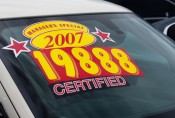Get To Know Your Car: Reading Your Owner’s Manual

By Paul Crosby, TestDriveNow.com
Today’s automobiles are incredibly complex machines. They are composed of literally thousands of individual components and hundreds of unique systems. Modern vehicles are faster, safer and more reliable than ever before. No matter how great they are when new, all vehicles need to be maintained properly in order to keep them running at their peak. The best way to preserve a vehicle’s performance, and safety, is to follow the guidelines set down in the vehicle owner’s manual. Here are just a few of the key areas that the manual will address:
• Oil changes. The oil change intervals will vary widely depending on the type of vehicle and the manner in which it’s driven. For example, cars that see frequent, stop-and-go city traffic will generally require more oil changes than cars with lots of highway miles. The advent of synthetic oils in modern cars has dramatically increased the mileage between changes. These types of oils still need to be changed regularly, just not as often. The car’s manual will also let the owner know what grade of oil to use for his/her vehicle. This is very important info for cars that operate in extreme weather condition (i.e.…below freezing and/or super hot climates).
• Tire rotation and balance. Tires should be rotated on every vehicle at the intervals specified in the owner’s manual. This will pay huge dividends through better ride and handling, braking and to ensure that tires wear evenly. Tires can be very expensive, thus rotating a car’s tires regularly is an easy way to extend the tire life and save money. Another crucial area when rotating tires is to have all four wheels balanced. Most independent shops and dealerships will perform this process as part of the tire rotation service. Having the wheels balanced is crucial to preserving the “feel” of a car, which includes avoiding annoying vibrations at highway speed.
• Regularly scheduled maintenance. This is a very broad term that covers a huge number of items. The maintenance schedule spelled out in the manual is designed to cover all of the major systems in the vehicle: engine, transmission, suspension, electrical, wheels/tires and bodywork. If possible, follow the guidelines as close to the manufacturer’s recommendations. This will increase a vehicle’s chances of trouble-free driving today and down the road.
While most people feel that the guidelines in the owner’s manual are a bit “overkill,” they should not be ignored. The engineers who design, test and build each vehicle are the ones who write these manuals. Everything in these manuals is there to educate the owner on how to properly maintain their car. Follow their guidelines to ensure the best possible reliability and performance of any vehicle over its lifetime.

 Are Certified Pre Owned Vehicles Worth The Premium That Dealers Charge?
Are Certified Pre Owned Vehicles Worth The Premium That Dealers Charge?